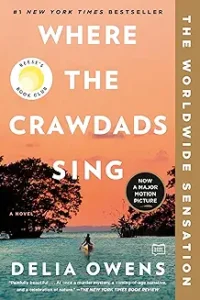Where the Crawdads Sing by Delia Owens 2018
Right after reading ‘The Yearling’ which took place in the swamps, marsh, and back country of rural Florida, I found myself on the North Carolina coast in a world of lagoons, swamps, marshes, and sand bars. I had intended to read this 2018 best seller for years, and finally, spurred by a recommendation of a neighbor, I borrowed it from the Brownsville library and read it in two days.
It’s a gripping, moving, and thoroughly engaging story that is hard to characterize as far as its genre. It’s a murder mystery. It’s a beautiful paeon to the North Carolina barrier beach environment. It’s a sad commentary on the racial prejudice in the South in the 1960’s. It’s a testimony to the resilience of human beings. It’s a love story. It’s a story of violence towards women. It’s a story about the healing power of love and family. Most of all, it’s a darn good read!
As the narrator flips back and forth from a 1969 murder of Chase Andrews to the disaster that is the family of five year old Kya Clark in 1952, these two stories converge with a sense of doom and fatality Kya, known to the residents of Barkley Cove as ‘The Marsh Girl’, is abandoned by her mother, sisters and brothers and ultimately by her horrendous father at the age of 5, but manages through incredible tenacity, creativity, and good fortune to survive in a shack on a lagoon far into the woods. Never going back to school after just one day, she learns to read and ultimately becomes a famous author of natural history books about her environment. She reconnects with a brother, has some spending money for the first time, is supported by a Black couple , Jumpin’ and Mabel, and while remaining a loner, is doing well until the aforementioned Chase Andrews assaults her in an attempted rape. Kya’s trial for murder is a tense and taut penultimate finish to the book, but don’t miss the final pages!
This book could easily have been a soppy, sugary story of success, and I went back and forth between feeling it was a potential classic vs an ‘Oprah Book Club’ contender. But Owens, in this her first novel after a successful career teaching and writing about wildlife in Africa, writes so beautifully that it all works, and I think it’s a long term keeper. This is one of those books where the first page captured me with its beautiful writing and where the characaters, plot, and setting made me want to return to reading it when I was involved in doing other things. Here’s that first page from the Prologue: “Marsh is not swamp. Marsh is a space of light, where grass grows in water, and water flows into the sky. Slow moving creeks wander, carrying the orb of the sun with them to the sea and long-legged birds lift with unexpected grace–as though not built to fly—against the roar of a thousand snow geese. Then within the marsh, here and there, true swamp crawls into low-lying bogs, hidden in clammy forets. Swamp water is still and dark, having swallowed the light in its muddy throat. Even night crawlers are diurnal in this lair. There are sounds, of course but compared to the marsh, the swamp is quiet because decomposition is cellular work. Life decays and reeks and returns to the rotted duff; a poignant wallow of death begetting life. One the morning of October 30, 1969, the body of Chase Andrews lay in the swamp, which would have absorbed it silently, routinely. Hiding it for good. A swamp knows all about death, and doesn’t necessarily define it as a tragedy, certainly not a sin But this morning two boys from the village rode their bikes out to the old fire tower and, from the third switchback, spotted his denim jacket.”
That is great writing—vividly descriptive and evocative, the words and sentences flowing effortlessly and filled with subtle allusions to the story that is about to unfold. I loved it.



